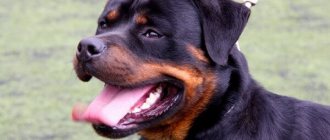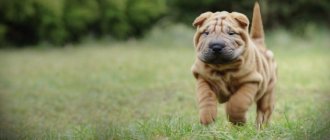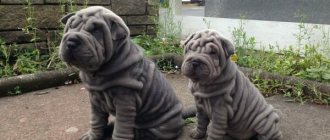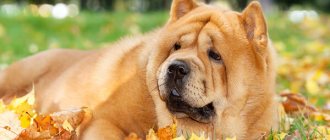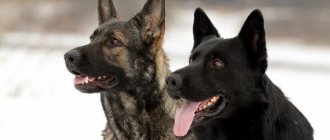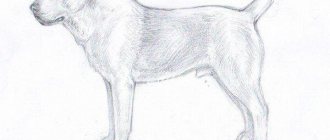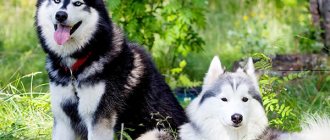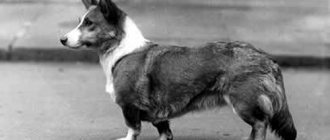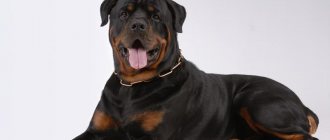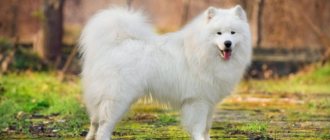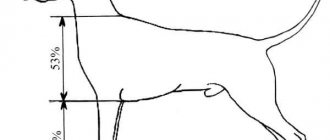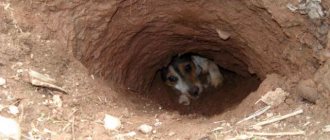To date, there is no reason for tail docking in dogs, except as indicated by a veterinarian or as may be required by the professional activities of dogs involved in rescue operations or performing security tasks.
Almost all EU countries, one after another, with the exception of the East Slavic states, have abandoned the useless and inhumane operation of tail docking.
In Russia there is no such restriction. The list of breeds for which tail docking is recommended for aesthetic reasons is very long. Here are just a few: Pit Bulls, Staffordshire Terriers, Doberman Pinschers, Rottweilers, Asian Shepherds, Boxers, Poodles and Spaniels.
Description of pets
Traditionally, males are larger than females in size - larger and heavier . They have a medium-length head, a moderately high forehead line, and pronounced cheekbones.
Dogs have semi-erect triangular ears that form a straight line with the top of the skull. The eye color should be dark brown, and their shape should be almond-shaped (shown in the photo).
Rottweilers have short, coarse hair with an invisible undercoat. The tail in its natural form should extend the line of the back.
The Rottweiler is a fighting dog that requires maximum patience and time from the owner..
This is the smartest dog that is easy to train, but if not properly trained it can be aggressive and even dangerous not only for others, but also for the owner and members of his family.
Breed standard
Rottweiler breed standard (example in the picture) :
- Weight. Males must weigh at least 50 kg, females - 40-42 kg.
- Height at the withers. For males it is 61-68 cm, for females – 56-63 cm.
- The color should be black with tan on the face, chest and legs. The color of tans can be any shade of brown - from red to red-brown. Any deviation from this description is a paint defect. A purebred Rottweiler can never be long-haired, have no undercoat, or have a soft, short, wavy coat.
- Lifespan. For Rottweilers it is not long - 8-12 years.
- Character. Rottweilers are determined and brave dogs, but at the same time willful and independent. They are difficult to provoke into aggression. Well-trained dogs will become excellent protectors and watchdogs. To become an authoritative owner for a Rottweiler, the dog’s respect will need to be earned. The RKF standard states that traits such as cowardice, angry and distrustful behavior are regarded as defective character traits.
- Intelligence. These are very smart dogs that are easy to train. They have a good memory and quickly adapt to changing conditions.
- Security and guard potential. Most often, this breed is bred for official purposes. Dogs of this breed are preferred by law enforcement agencies and security forces. Rottweilers perform excellent guard and escort duties, and they also have great abilities in finding explosives and narcotic substances.
Description of the pet
The Rottweiler's constitution is balanced. The height of an adult male can reach 68 cm, and that of a female – 63 cm. Body weight varies from 42 to 50 kg. A photo of a dog best demonstrates what a Rottweiler looks like.
The standard is described as follows:
Head. It is of medium size, the bump on the back of the head is quite pronounced, and the ears are characterized by a wide set. The muzzle is narrowed with a wide lobe and round nostrils.
Ears. They have the shape of a triangle and are usually docked.
Neck. It is distinguished by its strength and muscularity. Rottweilers have a straight back that extends into the lumbar girdle. The croup is medium in size and widened.
Tail. In this breed it is stopped.
Limbs. Strong paws are set wide, and the elbows are pressed to the body.
Life is tailless
Why does a dog need a tail? This organ in such animals serves as a kind of steering wheel, a control lever. He is an active assistant when the pet is in fast motion, he suddenly needs to turn or run along a log or any uneven surface. It is also a way of communication that can tell a lot about the animal’s mood and intentions. Everyone knows about the positive wagging of the tail, which shows friendliness, or the tucking of the tail when fear is manifested. The animal makes sends with its tail, moving it to the left or to the right. Tailless dogs are deprived of this opportunity. So what good is cupping?
It turns out that the procedure comes from ancient times. In the old days they believed that docking saved dogs from such a serious disease as rabies. After some time, the tails began to be cut off for representatives of service or fighting breeds, as the most painful places. Animals intended for hunting were shortened so that they would not injure themselves by clinging to bushes.
Let's go. This has survived to this day, so it is difficult to imagine some breeds of these animals without docking.
But now there are new standards. In some European countries, docking of dogs is prohibited. Everything would be fine. For people who are, the length of the tail is not so important. The main thing is that he should be distinguished by loyalty, devotion, complaisance, and also be cheerful and cheerful. Difficulties arise when dog owners plan to take them to all kinds of exhibitions.
If specific evaluative standards are defined for tailed representatives, then what awaits those who are usually seen as tailless? True, docked animals are not yet deprived of attention in our country. They are usually given preference.
But over time, probably, such an inhumane operation will generally sink into oblivion. A clear indication that many European dog shows no longer consider docked representatives. And considering that there will be more and more such exhibitions, soon tailless dogs will completely step aside.
The conclusion here is quite clear. If you are counting on “career growth” for your pet at the European and world levels, then when choosing a breed, think about tailedness.
Of course, a lot can be said about whether a dog’s tail should be trimmed. There are many supporters of this procedure, as well as opponents. Only one thing is clear: tailless life does not bring much joy to the dogs themselves. So is it worth injuring a pet with this, albeit not so complex, surgical intervention just so that it matches the accepted appearance? Only its owner should decide this. As a result, a tailless dog lives and runs as usual, but it does not have full maneuverability, stability, or sociability. Therefore, you should not cut off this important part of her body unless absolutely necessary.
Puppy age suitable for surgery
We figured out why dogs are docked. Now, let's look at the average age of a pet at which surgery can be performed. Let's start with the fact that almost a third of all known breeds undergo surgery:
- Dobermans, Rottweilers;
- Great Danes;
- Setters, terriers;
- Boxers, poodles.
The list could go on for a long time, but the essence will not change. Cupping is a tradition that has survived to this day from ancient times. During the times of the Roman Empire, this operation was carried out on dogs for their activity - hunters, watchmen, rescuers, shepherds had no need for long dangling tails, which were considered an “extra attribute”.
Today, many consider the operation pointless - dogs living in the city are not involved in work (with the exception of the watchman), it turns out that there is simply no point in getting rid of ears and tails.
How does the procedure work?
The surgical technique is not complicated, but sterility, firmness in movements and self-confidence are important:
- The puppies' mother retires to another room for a walk so that she does not worry.
- Scissors are disinfected with alcohol or vodka. You can boil them.
- The puppy is placed with its back up. The assistant holds the baby tightly, pointing his tail towards the operator.
- The skin on the tail stretches from tip to base. The base is tightly squeezed with two fingers, and the part behind 1-2 vertebrae is quickly cut off with scissors. You need to cut so that the blade of the scissors passes only between them.
- Continue squeezing the base for 1-2 minutes to prevent bleeding. The wound is blotted with a napkin and sprinkled with potassium permanganate powder or cauterized with iodine and treated with peroxide.
- The puppy is put into a separate box and the next one is processed.
Within a couple of days after surgery, the wounds are examined for bleeding. As a rule, at the age of 2-5 days the procedure does not cause negative consequences.
There is another way to dock the tail. It consists of tightly pulling the base of the tail with an elastic band. The tip of the pulled ponytail stops receiving blood, and after a few days it dries out and falls off. This option is bloodless, but if the elastic is not tightened enough, it will not dry out, and the puppy will experience pain.
Breed standard
For the Rottweiler breed, a tail length of 1-2 vertebrae is acceptable, no longer allowed. In addition, the edge of the stump should be smooth and neat. The Rottweiler with tail and ears corresponds to the accepted standard. The animal's tail should be straight, without kinks. In a calm state, it is lowered down; when excited, do not rise above the level of the back. A ring bend is considered a deviation.
Rehabilitation after surgery
If docking was carried out at an early age, then no special conditions are created for the puppies. Only more often than usual do they change the bedding and bring the puppy to the mother for feeding, making sure that the bitch does not lick the wounds on the tails. When performing an operation using anesthesia at 2 months and later, after the puppy emerges from this state, it is fed little by little with liquid food. The bandage on the stump is changed daily.
It is useful to sprinkle the healing wound with streptocide powder.
Can Rottweiler ears be cropped?
For Rottweilers, according to the modern breed standard, ear cropping is not required. They dogs should be semi-hanging, the tips fit snugly to the head.
Whether your pet's tail needs to be docked is up to the dog owner to decide. Many people think it is impossible to inflict torture on a pet for the sake of aesthetic pleasure. Other dog breeders find the tailless Rottweiler more massive and noble. Carrying out surgery at an early age does not leave negative marks on the dog’s health.
Source
What does a puppy look like?
A Rottweiler puppy should generally look like a smaller version of an adult dog (below in the photo) .
He should move confidently, without swaying or limping. Their legs are straight and muscular, parallel to each other.
Up to three months, the puppy's head looks like a small copy of the head of an adult Rottweiler - a wide, short muzzle and a pronounced chin.
During adolescence, the proportions of the head may change.
The ears should be long and reach the middle of the cheekbones . They are triangular in shape and have a high, wide fit.
Until the puppy is one year old, the coat is straight and short, it should not curl. At an early age, it is allowed to be fluffy and soft.
Also, the brown tan on the fur is already quite clearly visible.
Small Rottweilers also have 28 baby teeth and a scissor bite..
Proper ear care for growing young German Shepherds
In order for a dog to meet breed standards, it is necessary to take care of the baby’s health and the proper formation of ear cartilage from a young age, following simple measures:
- up to 6 months, it is not recommended to stroke a German Shepherd puppy on the head and allow fights with other dogs to avoid deformation of the soft ear cartilage;
- When your pet is sleeping, you must ensure that the puppy does not press its head against the wall;
- to prevent the development of otitis media, it is recommended to regularly clean the ears of growing young animals;
- It is necessary to provide the puppy’s body with a sufficient amount of calcium from birth; for this, you can introduce cottage cheese, yogurt, kefir, bone meal or special mineral supplements into the little friend’s diet after consultation with a veterinarian;
- Do not stop giving mineral supplements if your ears become erect early. At the age of 3-5 months, puppies undergo a change of teeth, against the background of which the ears may fall if there is insufficient amount of calcium in the dog’s body;
- it is recommended to stimulate the work of the ear muscles for the natural erection of the ears; for this, in the presence of the puppy, it is necessary to make various new sounds that encourage the dog to raise his ears;
- chewing muscle movements also strengthen the ear muscles, so it is recommended that you let your puppy chew on safe toys and cartilage treats.
German Shepherd ears are cropped only in exceptional cases.
Contraindications
The procedure cannot be performed if the puppy has abnormalities in growth and development. The operation is prohibited if the dog is sick, since a weakened immune system cannot cope with the increased load. It is advisable to postpone docking to a later date if the pet behaves strangely for no apparent reason - eats little, shows apathy or aggression.
How to prepare your pet
It is safer to seek help in docking from a veterinarian or an experienced breeder of the breed. The price of this service in the clinic for newborn puppies will be 500-600 rubles, for adult pets - from 1500 rubles.
But if cupping is done at an early age, then you can cope with the procedure on your own. To do this you need to prepare:
- very sharp scissors;
- alcohol (vodka);
- potassium permanganate powder or iodine, hydrogen peroxide;
- elastic band;
- clean rags, paper towels.
In addition, you need a comfortable, well-lit table. An assistant will be required for the operation; he will hold the puppy.
Types of Rottweilers and descriptions
There are four Rottweiler breed standards registered in the world.:
- American.
- German.
- English.
- FCI standard (Federation Cynologique Internationale).
American breeders used German Rottweilers, which had certain deviations, to breed American standard dogs.
These were mainly dogs that were taller than their counterparts and had an aggressive character..
For American reasons, this breed was supposed to inspire fear and look impressive. She must do everything to protect the territory from those who encroach on it.
NOTE!
It is difficult for Rottweilers of the American variety to participate in various exhibitions due to deviations from the FCI standard.
Breeders of the English type Rottweilers also used German representatives of the breed when breeding. These two species are very similar to each other.
The only differences are in character . English Rottweilers, like their owners, are quite reserved and can remain cool in almost any situation. Exceptions are situations when one of the family members is at risk.
When drawing up the standard for the Rottweiler, the International Canine Federation relied specifically on the German type of this breed.
But in addition to the official ones, there are also unofficial types of this breed.
Almost every country had its own approach to breeding Rottweilers..
Rottweilers of the Finnish line have elongated muzzles and ears. This is explained by their crossing with Russian hounds to improve their sense of smell.
In Austria, this breed is used exclusively for military purposes. They are always on army territory and are raised and trained from different ages. This variety is shorter than German Rottweilers, better developed physically and has no subcutaneous fat.
There are no rules in the Italian Rottweiler breeding line. Therefore, they often have dogs with defects and abnormalities.
Italian Rottweilers are often called mini Rottweilers due to their build..
When will the Rottweiler's tail be legalized?
Quote: Message from Tamara…………..That’s cool!!! It wouldn’t hurt to first study the anatomy and physiology of a dog before writing such angry and absurd “libel”. First, you need to study anatomy and physiology...before you sit and write. They have mutilated the breed and continue to mutilate it!!! Some out of “humanity”, although humanity is somehow hypocritical, others worshiping Western trends! The Rottweiler was originally bred with a docked tail standard. But what about docking of dewclaws, like castration... or other surgical interventions... we do not have the right to decide for a dog whether to undergo surgery or not. The widespread leaving of tails on Rottweilers leads to a distortion of the appearance of the breed and will ultimately require a change in the breed standard. Rottweilers lose their power and strong jumping ability. In countries where tail docking has long been prohibited, Rottweiler breeders began to note that if a Rottweiler has a tail, the muscularity of the croup changes, from wide and powerful to narrow and flat. Anyone who is even approximately familiar with the history of the breed knows that the Rottweiler has been a dog without a tail since time immemorial. The short tail was a distinctive feature; the short tail, emphasizing the individuality of the breed's style and giving the Rottweiler a unique charm, can be called symbolic. The Rottweiler is a working service dog that should be powerful and maintain its working qualities, and not a lap accessory. Veterinary aspect: Considering the problem of humanism from the perspective of veterinary medicine, I would like to express the opinion of many, many dog breeders. Since the influence on such prohibitions comes from the West, it is appropriate to ask: what about the widespread practice of castration of males and sterilization of females there? After all, in fact, this is monstrously inhumane, even cynical in some ways, but it is convenient for human society, and therefore does not raise questions. It seems that this is where the rights of an animal to have a full-fledged organism are blatantly violated. In my opinion, dewclaws are justifiably docked. Maybe it’s worth leaving them in the interests of humanity? Let the dog injure them on the crust and sedge, but our conscience will be fine... What about other operations that cause much more pain and suffering than tail docking at three days of age? Perhaps the time has come to consider their feasibility in the light of humanism? After all, these operations are performed by a person without asking the dog’s permission, and in natural conditions the animal either recovers on its own, without emergency intervention, or dies. So why is it possible to save an individual animal using techniques that are very painful for him, but doom an entire breed to extinction by freeing dogs from a little pain in puppyhood? In addition, some older breeders use a painless and bloodless method of tail docking. Anatomical aspect: For hundreds of years, the Rottweiler has been bred as a multi-functional dog breed with a docked tail. Although not a high-speed dog, the Rottweiler still has very productive movements and good dynamic characteristics. He has confident movements, stable gaits, and a powerful throw. If you compare the movements of a Rottweiler, Doberman, Boxer, for example, with a German Shepherd, Labrador and other “tailed” dogs, you can notice their special type, developed over the years. Tailless dogs are deprived of the ability to “rule” and balance their tail and do this through a specific rearrangement of muscles that has developed over generations. At a gallop, these dogs resemble a swift core; at a trot, they are distinguished by a monolithic, muscular, straight profile top. But the set and shape of the tail, if left, can be anything. The animal will have to adapt its body to movement in new conditions, from which this body has become “unaccustomed” over many centuries. Selection aspect: Experts know that puppies are born with different tails - long, short, with one kink and many congenital kinks, etc. Moreover, the relationship is known: the shorter and wider the head, the sooner we should expect kinks and short tails. Adult Rottweilers have even more interesting tails: their tails can be sickle or ring, lowered or set vertically, smooth and feathered. But you never know what else can be observed, because no one has ever carried out a selection on this basis; there were enough other worries. Just imagine that a lot of animals, excellent in all other respects, were culled. How much has the breeding population narrowed? And what individuals that do not meet the fundamental requirements for a Rottweiler, but with the correct tail, will “get through” into breeding to secure the correct tail shape! Step back? No, jump! But, you say, let’s select in stages, let’s allow for several variations of the tails. And the once majestic rings of magnificent, selected exhibition Rottweilers will begin to resemble a pack of different-tailed mongrels... The effect is the same - a decrease in the popularity of the breed and interest in it. Practical aspect: The most banal, but significant for any Russian citizen. The short tail of a large dog makes it easier to keep. It's no secret that in our small-sized apartments the issue of saving space is very acute. Probably, our Western colleagues will not understand us, but where can you go... In our narrow corridors, “tailed dogs” smash their tails on the sharp corners of the furniture until they bleed, painfully whip the legs of the guests and hosts they meet, and knock down small children. In addition, it is easy to step on the tail in the dark; the dog carries a lot of dirt on it in rainy weather. It is no coincidence that many people who have chosen the Rottweiler out of all breeds cite the absence of a tail as one of the arguments in favor of choosing the breed. And if you look at how things stand in practice in countries where this ban has already been implemented? Breeders and owners of those breeds affected by the veto travel to countries “free” from this ban, issue litters there or register dogs. Need I say that only the most serious dog breeders go to such difficulties, advocating for the standard, familiar appearance of their dogs? Why create additional problems for those who selflessly work for the benefit and prosperity of their breed? — — — Added — — — Quote: Message from Rottwesthouse There are trolls on the Internet with flayer tendencies Come on23 You’re being a hypocrite... if your dog gets sick and requires surgery, don’t operate on this same knackering...Rotsaler, Now is the time that every teapot wants to leave a significant mark in history. And they began to introduce their own standards, disfiguring the breed; the Rottweiler standard was and should remain without a tail. I still have manuals on dog breeding and the current standards were then considered vices. — — — Added — — — Quote: Message from n_velichutin I read the topic with the “killer” argumentation of opponents of the tail. There are no more problems than to be or not to be a tail. It’s only people with dislocated brains who put holes in their cheeks, drill holes in their heads, make holes all over their bodies and insert all sorts of metal trinkets into them. If some people are interested in this, then let them experiment on themselves, but what about dogs? Personally, a Rottweiler’s tail doesn’t bother me at all. The tail is a good indicator of a dog's mood. I’m wondering, if you’re a girl, it’s not clear from your nickname who you are... have you pierced your ears? As for the tail of the roti, if you know the dog’s mood by the tail, then you are a bad owner, the dog’s mood is clearly visible even without a tail!
Tail docking for a Rottweiler
Grooming
Rottweilers shed a lot, so special attention must be paid to grooming their coat. Molting occurs several times a year. The animal needs to be combed several times a week. In this case, the old hair will be removed and the growth of new healthy and beautiful hairs will be stimulated.
A dog should be taught to groom itself from early childhood. In addition to grooming procedures, this will allow you to get closer to the animal and establish a truly trusting relationship.
Brood of two-year-old Rottweilers
Care after cupping
A docked ponytail requires almost no maintenance. It is enough to change the antiseptic bandage once every 3 days until complete healing. But the healing process of the ears needs to be carefully monitored.
After the operation, the cut edge is treated daily with a solution of brilliant green. If the puppy tries to scratch its ears, it is better to wear a protective Elizabethan collar. Any scabs that appear must be softened with peroxide and removed with a cotton swab.
After complete healing, a bandage is applied to the ears after 5–7 days. It is made from available materials: foam rubber, adhesive plaster and bandage. Foam rollers are placed inside the ears, an adhesive plaster is wrapped on top of the shell and secured in a standing position with a bandage.
Important! If an inflammatory process occurs, it is important to contact a veterinarian.
Main color
The main color of the Rottweiler is black. Its name is tan.
Tan spots have clearly defined boundaries and are located in certain places:
- On the head in the area of the cheeks and eyebrows.
- Under the larynx.
- In the chest area.
- On shoulders.
- On the inner thighs.
- In the anal area.
- At the bottom of the paws.
Possible complications
The most common problem after cupping is scarring. Unsightly healed edges of the ears or tail make the dog less attractive.
When using non-sterile devices, blood poisoning and the appearance of an abscess at the incision site may occur. Any inflammation is a bait for infections, because local immunity is sharply weakened.
Interesting! It is believed that an animal with a docked tail is less sensitive and more aggressive. The dog cannot show emotions like other dogs, so it has poor contact with others.
Popular colors
Deviation from the norm of color is a defect. Such dogs cannot participate in exhibitions, but are very popular with ordinary owners.
Common colors among Rottweilers include red, golden , brown, black without tan and albino. These colors appear either due to a genetic abnormality or are an inheritance from ancestors.
Dishonest breeders use such dogs, cross them and pass them off as unique, raising their prices several times over.
Dogs of non-standard color differ from others not only in coat color, but also in size, shade and tan boundaries . It may be completely absent on the face, or it may be lighter and have white spots.
Why is a Rottweiler's tail docked?
Rottweilers were bred artificially for baiting predatory animals, driving livestock, guarding territory and dog fighting. Using dogs for such purposes meant a high risk of injury. The tail is located in the defenseless zone of the animal's body. Predators or another dog could grab onto him and cause serious injuries. Therefore, docking was considered a necessity.
Today the procedure is not mandatory. Rottweilers are often kept simply for the love of her. They do not participate in battles, do not guard houses and livestock, and are not used for baiting. But many admirers of such dogs believe that the Rottweiler’s long tail looks ridiculous.
The breed standard is not limited to just the docking option. There are countries where only Rottweilers with uncut tails are allowed to exhibit. The standard involves docking from its base to two vertebrae. The decision about this is usually made by the breeder.
Sometimes tail trimming becomes necessary. It occurs when owners intend to attend Rottweiler shows or if the dog is injured. Docking of show specimens should be carried out on puppies before they reach the age of 6 months. Owners of the breed should remember that a Rottweiler without a tail may not be allowed to participate in international competitions. Therefore, before carrying out the procedure, you need to think about which exhibitions you plan to participate in.
What are the differences between boys and girls?
There are big differences between males and females in this breed.
Perhaps the most important difference is the size and weight. Males are larger and larger, females are smaller and more compact. This difference is easy to determine by eye.
Males are more aggressive than females and are stubborn . Therefore, males are suitable for experienced dog owners, and females are suitable for beginners, because they are more flexible.
But this does not mean that the future owner does not need leadership qualities. In any case, bitches become more attached to a person and learn better.
CAREFULLY!
The disadvantages of females include the period of estrus, and males tend to run after females during this period.
The owner of the bitch will also have to deal with the animal's pregnancy and childbirth.
Rottweiler training
Pets are confident in their own abilities and are courageous, so their owner must also be confident and courageous.
A person in the learning process must be able to show persistence and rigor towards his student.
The Rottweiler requires discipline, but will not tolerate rudeness. Success in learning should be rewarded with praise and tidbits. To prevent a dog from showing affection to only one family member, everyone should take part in its upbringing and training. You can, for example, create a schedule for the order of walks with your pet for all household members.
When choosing, you should take into account the fact that a female Rottweiler has a more gentle disposition. She is easier to train.
- Newfoundland - history of the breed, education, care + 73 photos
Chihuahua - history of the breed, description, temperament, attitude towards people and animals, care + 92 photos
Brussels Griffon - history, modern appearance, standards, character and content + 77 photos
The male has a complex and independent character. He will always try to show his leadership.
Veterinarians' opinions
Dinara, 34 years old, Ryazan
“I think Rottweilers should definitely have their tail docked. It makes them look like non-pedigreed dogs, like an ordinary mongrel. For some reason, people think that they should leave what is given by nature. Only Rottweilers were bred artificially - what kind of nature are we talking about?”
Pavel, 38 years old, Samara
“I recently saw a long-tailed Rottweiler. Unusual, but interesting. I think that the owner himself should decide whether to dock the tail or not. Everyone has their own beliefs on this matter.”
Why is the tail docked?
Nowadays, Rottweilers with regular tails are quite common, but previously, due to the fact that they performed various dangerous tasks, their tails were docked to reduce the risk of injury from other animals.
Currently, tail docking is an optional procedure . It is done only to improve the appearance of the dog.
Cupping is usually done within 10 days after birth, while the vertebrae have not yet ossified.
Does cupping affect life expectancy?
Docking a Rottweiler's tail does not affect its life expectancy. The operation, performed professionally, is well tolerated. The puppies quickly come to their senses and after a few hours they begin to play, eat with appetite and move actively. The only complications that can threaten a pet’s life are complications that occur when infections enter the pit, if the procedure was carried out incorrectly or the dog was already an adult. In such cases, inflammation sometimes develops, bleeding begins, and compactions form that can transform into malignant tumors. The risk of negative consequences of cupping is small. If done correctly, it comes down to zero.
Consequences of the procedure
At first glance, there is nothing wrong with removing the tail. The simplest operation, after which you only need to treat the wound for a couple of days. In fact, experiments conducted on rats show that nerve injury negatively affects the sensitivity of the stump. Some experts argue that removing the tail vertebrae weakens the animal's motor skills. Another weak point is urination. The tail serves as a counterweight. When an animal is deprived of it, it acquires dysfunction of the musculoskeletal system, as well as pathology of urinary function.
Are ears cropped?
Rottweilers with cropped ears are a real rarity.
For this breed, such operations are almost never carried out. An exception may be ear lesions.
According to the standard, the ears of Rottweilers should be hanging and close to the muzzle.
Coat and color
The Rottweiler's coat is black with tan markings. The spots are located symmetrically around the cheekbones and eyes, on the throat and limbs, as well as in the perineum.
According to the standard, there should be no white spots on the wool.
The pet's coat is coarse with a dense and dense undercoat. This fur reliably protects the dog from frost in winter.
- The most popular dog names in alphabetical order with recommendations
Shar Pei - history of the breed, character traits, care and possible problems + 87 photos
- American Bulldog - history of the breed, appearance, specifics and characteristics, care (100 photos + video)
How to choose?
Knowing all the behavioral features and character of this breed, we can conclude that it is not suitable for everyone and certainly not for a beginner.
But if you are confident in your abilities, then before choosing a puppy, you need to familiarize yourself with some tips that will help you choose a healthy pet:
- Give preference to a curious puppy who does not hide, but rather licks your fingers and sniffs you.
- Ask the Rottweiler breeder to see the litter's parents. If he gives you unhindered access to the dogs, then there is nothing to be afraid of, but if not, then this is a reason to think about it.
- Observe the puppies' parents. Basically, they will inherit their qualities.
- Ask the breeder to confirm how many times the mother of the puppies has been bred. Rottweilers are prone to severe genetic diseases. It is best if the puppy is born at 1-3 gestation, and the mother is 2-5 years old. These indicators will reduce the tendency of diseases to a minimum.
- The most severe hereditary disease is hip dysplasia. It appears in dogs 2-3 months after birth. To be sure of the puppy’s health, ask the breeder for documents confirming that neither the puppy nor its parents have this disease.
- Ask any questions you have to the breeder. Watch how he answers them.
- Remember that a conscientious breeder will always ask for what purpose you are getting a dog and in what conditions the puppy will be kept.
Also pay attention to the general condition of the dog.
Even externally, the puppy should look healthy, well-fed, cheerful and active, without any flaws.
His coat should be clean, smooth and shiny, his teeth should be white and his gums should be pink..
Stages of the procedure
When performing an operation without anesthesia, it is better for the owner to hold the pet with his hands so that he does not escape, and the veterinarian carries out all the manipulations without errors. The procedure follows the following scheme:
- The tail is tightly tied with a strip of bandage closer to the base. This makes blood circulation in the appendage more difficult.
- An antiseptic is used.
- They feel the tail with their hands to mark the cutting line - it runs between two adjacent vertebrae.
- Using a scalpel or strong scissors, cut the tail along the intended line.
- Treat the wound with an antiseptic. If necessary, stitches are applied (small puppies do not need them).
- The bandage strip is removed half an hour after the operation.
The whole process lasts no more than 5 minutes. You can call a veterinarian to your home and carry out the procedure in more comfortable conditions for the dog, especially if it has already grown up. The operation scheme is no different from the clinic conditions.
It is not recommended to dock the tail yourself, since only a person with a veterinary education will do everything correctly. If the cut line is inaccurate, the dog will have a flaw for life; no corrections are provided. It is even possible to be disqualified from competitions and prohibited from mating.
Feeding
Above we mentioned super-premium food. You can buy special food made taking into account the characteristics of the breed. Or you can simply choose universal food. It must be of high quality - this is the path to a healthy dog.
A good super-premium food (holistic) costs about 6,000 rubles. Quite an impressive amount for a bag that will last for a month. But if you calculate how much money will be spent on natural products, then it is cheaper to buy high-quality food. At least it's completely balanced.
Have you decided to feed “natural”? We list here the necessary products:
- Lean meat: veal, turkey, beef. Chicken can cause allergies; its introduction into the diet should be approached carefully.
- Vegetables are a side dish for meat.
- The main grains given to dogs are rice and oatmeal.
- Sea fish is lean, boneless.
- Dairy products: cottage cheese, kefir, cheese.
- Boiled eggs.
- Fruits: apples, unsweetened pears.
- Offal.
- Crackers made from black and wheat bread as a delicacy.
An adult pet is fed twice a day. In the morning and in the evening.
Representatives of the breed are prone to obesity. Be careful not to overfeed your dog. His ribs should be palpable. If, by placing his hand on the dog’s ribs, the owner discovers a thick layer of fat, it’s time to reconsider his diet. And make adjustments to the single portion, reducing it.
What to feed your Rottweiler
Pet owners can feed their four-legged friends in two ways - ready-made food and natural food. It is necessary that the dog receives high quality food.
When feeding natural food, the menu should include meat, dairy products, eggs, low-fat fish, and cereals.
If the owner decides to feed his pet commercial food, then he should choose diets intended for large breeds, classes: premium or super-premium.
